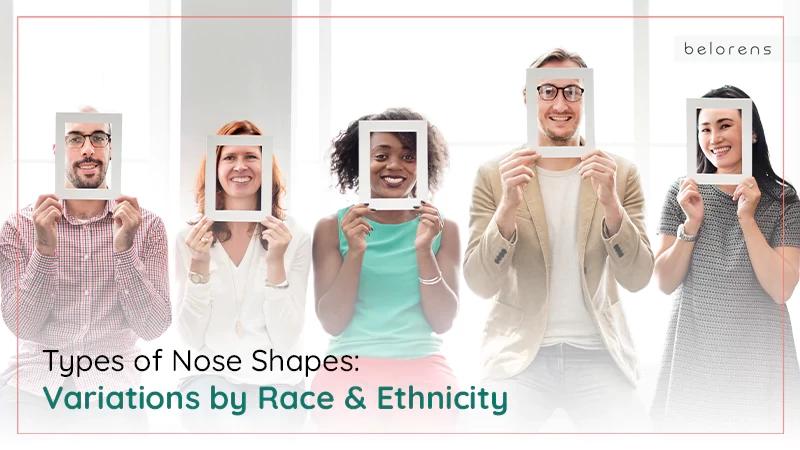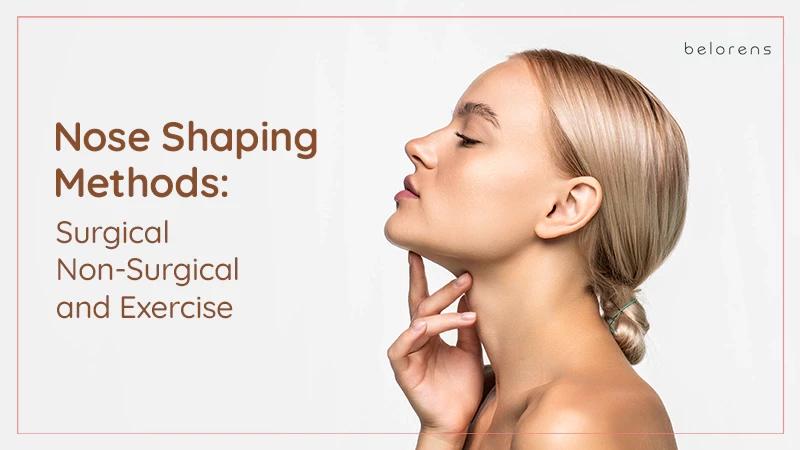Published on 27 Apr 2024 | Last updated on 24 May 2024
Bruising and Swelling After Rhinoplasty: What You Need to Know
- ByMedical Content Team
- Medically Reviewed byDr. Sabine Kulhanek
Fact checked

After undergoing nose surgery, whether cosmetic rhinoplasty or septoplasty, patients often encounter two uninvited guests during their recovery: bruising and swelling. These common post-operative side effects can be concerning, yet they play a crucial role in the healing process. In this blog post, we will explore the realities of bruising and swelling after nose surgery, providing valuable insights into what to expect and how to manage these temporary but inevitable companions on the path to a more refined nasal appearance.
Is swelling and bruising normal after a nose job?
Swelling and bruising are common and expected side effects following a rhinoplasty procedure. The extent and duration of nose surgery swelling and bruising can vary depending on the individual's anatomy, the specific techniques used during surgery, and the body's healing response.
In the initial days and weeks after rhinoplasty, patients can experience swelling around the nose, eyes, and cheeks, along with bruising in similar areas. These effects typically peak within the first few days post-surgery and gradually subside over the following weeks and months as the body heals.
What causes the face to swell and bruise after nose surgery?
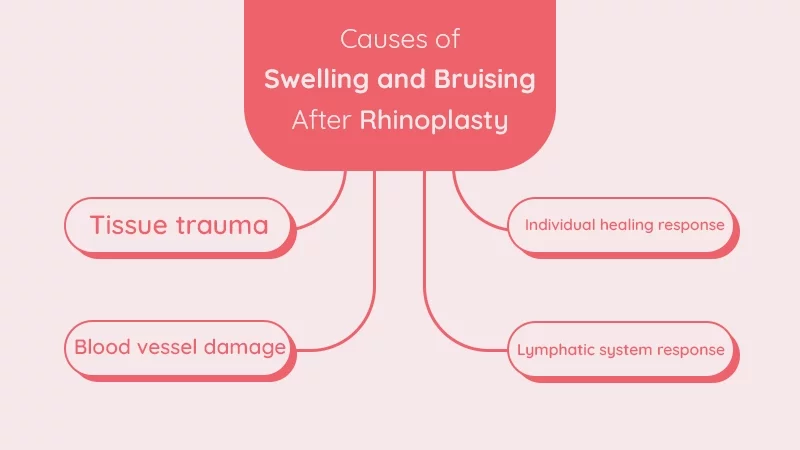
Bruising and swelling after rhinoplasty are primarily caused by the trauma and manipulation of the nasal tissues during the surgical procedure. The following factors contribute to face swelling and bruising post-nose surgery:
- Tissue trauma: During rhinoplasty, the surgeon makes incisions, reshapes cartilage and bone, and manipulates the nasal tissues to achieve the desired aesthetic or functional outcome. This tissue trauma triggers the body's natural inflammatory response, leading to swelling as a protective mechanism to aid in the healing process.
- Blood vessel damage: The surgical process can result in damage to small blood vessels beneath the skin's surface, causing blood to leak and collect in the surrounding tissues. This accumulation of blood manifests as bruising, also known as ecchymosis, and typically appears as discoloration around the nose, eyes, and cheeks.
- Lymphatic system response: Swelling after nose surgery is also influenced by the body's lymphatic system, which helps remove excess fluid and waste products from the tissues. Disruption of the lymphatic vessels during surgery can lead to fluid retention and swelling in the operated area.
- Individual healing response: Each individual's healing process is unique, and factors such as genetics, overall health, and adherence to post-operative care instructions can impact the extent and duration of swelling and bruising after nose surgery.
How to reduce rhinoplasty swelling and bruising?
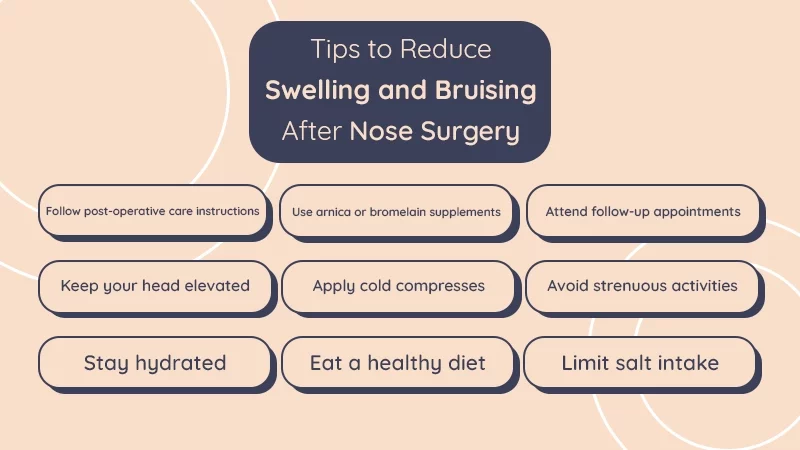
While bruising and swelling after a nose job are inseparable parts of the procedure, which can't be completely prevented, there are steps you can take to help minimize these side effects and promote a smoother recovery process. To reduce bruising and swelling after rhinoplasty, consider the following tips:
- Follow post-operative care instructions: Adhere to your surgeon's specific post-operative care guidelines, including instructions on medication, wound care, and activity restrictions.
- Keep your head elevated: Elevate your head while resting or sleeping to help reduce swelling following nose surgery and promote drainage of excess fluid from the surgical site.
- Apply cold compresses: Use cold compresses or ice packs on the swollen areas to constrict blood vessels, reduce inflammation, and alleviate bruising and swelling. Be sure to follow your surgeon's recommendations on the frequency and duration of cold therapy.
- Avoid strenuous activities: Refrain from engaging in strenuous activities, heavy lifting, or exercises that can increase blood pressure and exacerbate swelling and bruising in the surgical areas.
- Stay hydrated: Drink plenty of water to stay hydrated, which can help flush out toxins and reduce fluid retention that contributes to swelling.
- Eat a healthy diet: Consume a balanced diet rich in fruits, vegetables, and lean proteins to support the healing process and reduce inflammation. Avoid foods and drinks that can contribute to bloating and water retention.
- Limit salt intake: Excessive salt consumption can lead to fluid retention and worsen swelling. Limit your salt intake to help minimize post-operative facial swelling.
- Use arnica or bromelain supplements: Consider taking arnica or bromelain supplements, known for their anti-inflammatory properties, to help reduce bruising and swelling post-rhinoplasty. However, consult with your surgeon before starting any new supplements.
- Attend follow-up appointments: Attend all scheduled follow-up appointments with your surgeon to monitor your healing progress, address any concerns, and receive additional recommendations for managing swelling and bruising.
By following these tips and maintaining good communication with your surgeon, you can help reduce swelling and bruising after rhinoplasty and promote a smoother and more comfortable recovery process.
Also Read: Rhinoplasty Recovery Tips: 15 Essentials to Guide You to a Swift Nasal Recovery
How long does nose job swelling and bruising last?

The duration of swelling and bruising after a nose job (rhinoplasty) can vary from person to person based on individual healing factors and the extent of the surgical procedure. Here is a general timeline for the resolution of swelling and bruising following rhinoplasty:
- Immediate post-op (days 1-7)
- Swelling: Swelling is typically at its peak during the first 2-3 days after surgery and gradually begins to subside.
Bruising: Bruising may appear around the eyes, nose, and cheeks and typically peaks within the first week.
- Immediate post-op (days 1-7)
- Swelling: Swelling is typically at its peak during the first 2-3 days after surgery and gradually begins to subside.
- Bruising: Bruising may appear around the eyes, nose, and cheeks and typically peaks within the first week.
- First week to two weeks
- Swelling: Swelling continues to decrease, but the nose may still appear swollen and slightly distorted.
- Bruising: Bruising starts to fade, and discoloration diminishes as the blood is reabsorbed by the body.
- Two weeks to one month
- Swelling: Most of the initial swelling subsides, but some residual swelling may persist, especially in the nasal tip.
- Bruising: Bruising further fades, and most visible bruising should resolve by this time.
- One to three months
- Swelling: Residual swelling continues to decrease gradually, and the nasal shape refines further.
- Bruising: Any remaining bruising should be minimal or completely resolved by the three-month mark.
- Three to six months
- Swelling: The majority of swelling resolves during this period, and the nose begins to settle into its final shape.
- Bruising: Bruising is typically completely resolved by this stage.
- Six months to one year
- Swelling: Any residual swelling continues to improve, and the nasal contours become more defined.
- Bruising: There must not be any bruising at this stage, and the final results of the rhinoplasty become apparent.
It is important to note that individual healing rates can vary, and some patients may experience prolonged swelling or subtle changes in the nose's appearance over the course of the first year post-rhinoplasty.
Also Read: Diet After Rhinoplasty: What to Eat And Drink and What to Avoid
When to worry about post-rhinoplasty swelling and bruising?
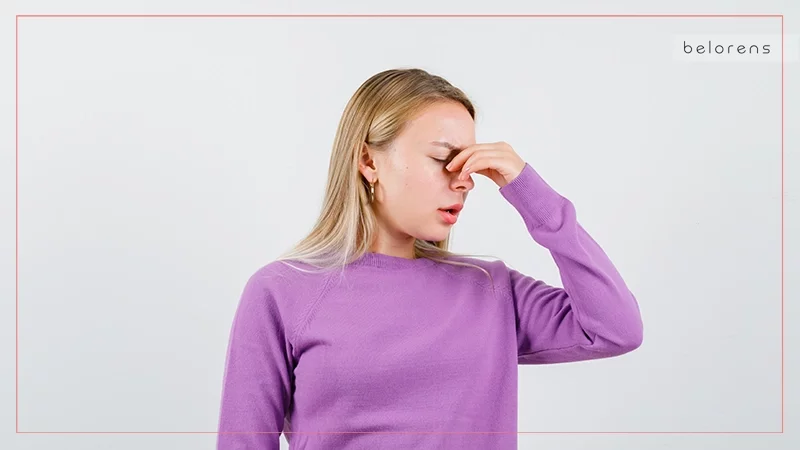
In most cases, rhinoplasty or septoplasty swelling and bruising are normal and expected parts of the healing process. However, there are certain signs and symptoms that may indicate a need for concern and prompt medical attention. You should consider contacting your surgeon if you experience any of the following concerning issues related to swelling and bruising after rhinoplasty:
- Excessive swelling: If you notice a sudden increase in swelling or if the swelling does not improve over time as expected, it could indicate a potential complication such as infection or excessive fluid accumulation (seroma).
- Severe bruising: While bruising is common after rhinoplasty, unusually severe or expanding bruising may be a sign of bleeding under the skin (hematoma), which requires immediate medical evaluation and possible intervention.
- Persistent pain: Intense or worsening pain that is not adequately controlled with prescribed pain medications may indicate an underlying issue that needs to be addressed by your surgeon.
- Warmth or redness: If the skin around the surgical site becomes unusually warm, red, or tender to the touch, it could be a sign of infection, and you should seek medical attention promptly.
- Fever: A fever above 100.4°F (38°C) could indicate an infection, and it is essential to contact your surgeon if you develop a fever after rhinoplasty.
- Difficulty breathing: If you experience sudden or severe difficulty breathing, it could be a sign of nasal obstruction or other complications that require immediate assessment.
- Changes in nasal appearance: Significant asymmetry, deformity, or unexpected changes in the shape of your nose beyond the normal healing process should be discussed with your surgeon.
- Persistent swelling and bruising: If post-rhinoplasty swelling and bruising do not improve or continue to worsen beyond the expected timeline outlined above, it may be necessary to seek further evaluation to rule out any complications.
It is crucial to maintain open communication with your surgeon throughout the recovery process and report any concerns or unusual symptoms promptly. Your surgeon is best equipped to assess your individual situation, provide guidance, and address any potential issues related to post-rhinoplasty swelling and bruising.
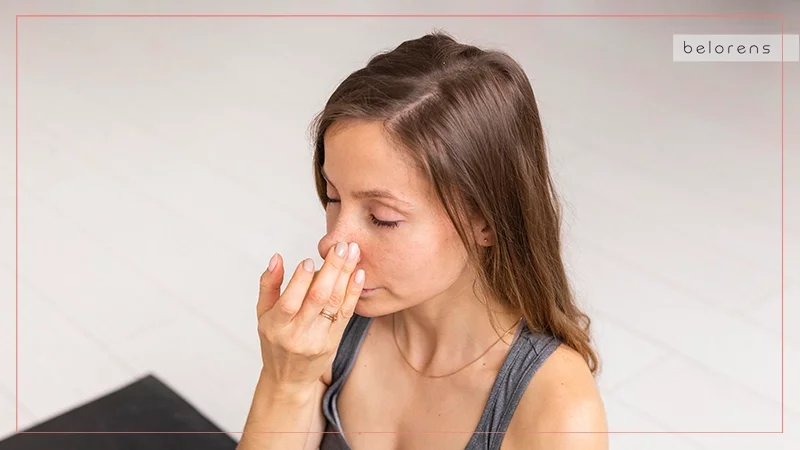
Summary
In this article, we discussed swelling and bruising after rhinoplasty, highlighting their normalcy and expected timelines. Swelling and bruising are common after nose surgery, whether cosmetic or functional (septoplasty). Swelling typically peaks in the first week and gradually decreases over several weeks to months. Using cold compresses, keeping the head elevated, staying hydrated, eating a healthy diet, and avoiding strenuous activities can help reduce swelling. Concerning signs include excessive swelling, severe bruising, persistent pain, redness, fever, breathing difficulties, nasal shape changes, and prolonged swelling and bruising. Communication with your surgeon is key for monitoring and addressing any unusual symptoms during the recovery process.
